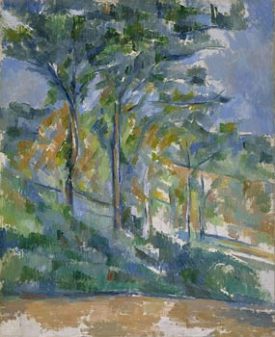Paul Cezanne
Landscape: The forest clearing, 1900.
Cezanne liked painting landscapes from the early 1870s and then turned into an outdoor painter after the expeditions he went on with Pissarro. He enjoyed the brightness and immediacy of impressionism and then by the late 1870s he began to develop his own style. This piece is a triad colour scheme as he’s used separate colours around the colour wheel; he’s used monochromatic colours of the blue to add value to the sky, hill lines and depth, used the orange to the ground and hill tops and parts of trees for tone and also monochromatic colours of green in the bushes and trees to paint the piece- by using these three evenly spaced colours from the colour wheel it makes a triad colour schemed piece. He gave a distinct solidity to the forms in his pictures and the markings of the brush strokes show repetition in his work and the regularity of his individual style. He didn’t choose to paint the real world but a more 2 dimensional canvas and from this he called his paintings ‘Constructions after nature’. His techniques included overlapping strokes of paint and colour so one seemed in front of the other and came towards the surface to present an object; each layer of paint used different colours, one with warm, reds and yellows that appears to come towards us and catch our eye and then another with cold, blues and greens that seem to recede. Parts of the painting hasn’t included paint and this is where it’s a white, bright colour which is actually the bare canvas left as it is. This contrast of warm and cold colours tone and are used effectively in the image to reflect the different areas of the forest (of which has an unknown recording of where it has been painted) as it recedes to the background. The image makes the viewer feel warm and flowing but at the same time a cool, cold and calm mood with the flatness to the piece.
